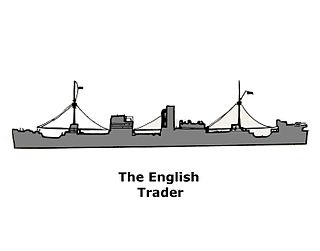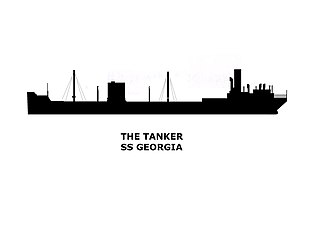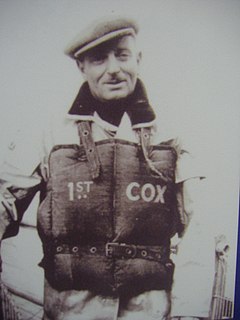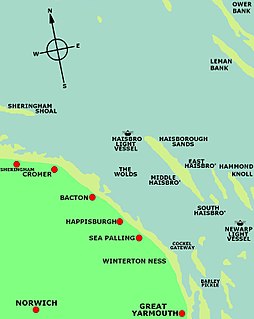
Henry George Blogg GC BEM was a lifeboatman from Cromer on the north coast of Norfolk, England, and the most decorated in Royal National Lifeboat Institution (RNLI) history.
RNLB Mary Stanford was a Royal National Lifeboat Institution (RNLI) Liverpool-class lifeboat stationed in Rye Harbour.

The SS English Trader was a British merchant ship wrecked off the coast of Norfolk, England in October 1941. After falling behind a convoy during the Second World War of which she was a part, the ship ran aground on the Hammond's Knoll sandbank and began to break up during a gale. Several rescue attempts by lifeboats failed, but a further attempt the following day by the Cromer Lifeboat rescued 44 of the crew, three having already been lost.

The SS Mount Ida was a cargo ship built in 1938 by William Hamilton & Co. Ltd of Glasgow. Launched in 1938 as Arcscott, she was renamed Mount Ida after being bought by the Atlanticos Steam Ship Company Ltd, of Athens, Greece. She was wrecked in 1939 after being in service for only about 18 months.

SS Georgia was an oil tanker lost at Haisborough Sands off the coast of Norfolk, England in November 1927.

Henry "Shrimp" Thomas Davies BEM was a lifeboatman from Cromer on the north coast of Norfolk, England. His uncle, Henry Blogg, gave him the nickname "Shrimp" after seeing him as a tiny baby. In 1931 he joined the crew of the Cromer lifeboat H F Bailey and became coxswain in 1947, taking over from Henry Blogg. Davies retired in February 1976, after serving as coxswain of lifeboats Henry Blogg and Ruby and Arthur Reed, having been one of Cromer Lifeboat Station's longest serving coxswains.

SS Cantabria was a Spanish cargo ship which was sunk in a military action of the Spanish Civil War, off the coast of Norfolk 12 miles ENE of Cromer on 2 November 1938. The ship was shelled by the Spanish Nationalist auxiliary cruiser Nadir, which was part of General Franco's navy.

Haisborough Sands is a sandbank off the coast of Norfolk, England at Happisburgh. The shoal is 10 miles (16 km) long and 1 mile (1.6 km) wide and lies parallel to the North east coast of Norfolk. The shoal is marked to the north-west by north by the Haisbro Light Buoy, North cardinal. To the south-east by south is a light buoy South cardinal, and to the west by Mid Haisbro light buoy starboard hand. In 1995 there were three drying patches recorded to the north-north east and east-south east of the Mid Haisbro light buoy. Except at slack water their positions are indicated by tidal eddies particularly on the north west, and in slight or moderate seas the swell breaks on the shallower parts of the banks. There are several foul patches on the southern part of the shoal. Over the years this shoal has claimed many ships.

RNLB Henry Blogg was the eighteenth lifeboat to be stationed at Cromer in the county of Norfolk.

RNLB Louisa Heartwell was the sixth lifeboat to be stationed at Cromer on the coast of the English county of Norfolk She was launched from the beach station and was on station from 1902 to 1932. During her period on station at Cromer the Louisa Heartwell had only two coxswains during her 29-year career. They were Matthew James Buttons Harrison until his retirement in 1909, and then Henry George Blogg.

The Augusta was a private lifeboat which was stationed in the town of Sheringham in the English county of Norfolk She was launched on 14 November 1838 and stayed on station for 56 years until she was retired from service in 1894 after an inspection declared her to be unseaworthy.

SS Monte Nevoso was a cargo steamship that was launched in 1920 in England, owned in Italy, and wrecked in 1932 in the North Sea off the coast of Norfolk.
The SB Hibernia was a 75-ton spritsail Thames barge built in Greenhithe, Kent in England in 1906, and which was wrecked on the North Sea coast at East Runton during the night of 9/10 November 1937. Her crew of three were rescued by the Cromer lifeboat.

SS Meriones was a Blue Funnel Line refrigerated cargo steamship. She was launched in 1921 on the River Tyne as one of a class of 11 ships to replace many of Blue Funnel's losses in the First World War.
SS Gallois was one of seven merchant vessels which became stranded and then wrecked on Haisbro Sands of the Norfolk coast on 6 August 1941 during the Second World War. The SS Gallois had been part of a convoy with the designation Convoy FS 559.
SS Hopelyn was a Merchant vessel from Newcastle which became stranded and then wrecked on Scroby Sands of the Norfolk coast on 17 October 1922.

RNLB Benjamin Bond Cabbell II was a Cromer non self-righter type lifeboat stationed at Cromer Lifeboat Station in the English county of Norfolk from September 1884 until September 1902.

RNLB J C Madge was a Liverpool-class, non-self righting lifeboat stationed at Sheringham in the English county of Norfolk from December 1904 until June 1936 during which time she was launched on service 34 times and saved 58 lives. J C Madge was replaced by Forester’s Centenary (ON 786).

RNLB Foresters Centenary is a retired Liverpool-class lifeboat of the Royal National Lifeboat Institution (RNLI), stationed in the English coastal town of Sheringham in the county of Norfolk in the United Kingdom. The lifeboat was on station for 25 years between 1936 and 1961 when she was sold. She has been restored to her original condition and is exhibited in Sheringham Museum.

Henry Ramey Upcher was the second private lifeboat to be stationed in the English town of Sheringham in the county of Norfolk She was launched on 4 September 1894 and stayed on station for 41 years until she was slowly retired from duty and by 1935 had ceased rescue work completely. The Lifeboat is now on permanent display in her own museum housed in her converted original boat shed.

















